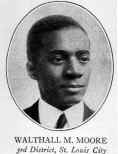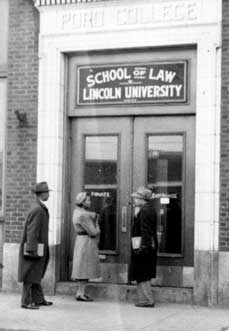| 1920 |
Elected as a representative from St. Louis on November 2, 1920, Walthall Moore became the first Black person to serve in the Missouri General Assembly. |

Walthall M. Moore, 1920
|
| 1921 |
The Missouri legislature authorized a Negro Inspector of Schools, as well as provisions to establish black high schools in counties with a population of over 100,000. |
| 1924 |
The Kansas City Monarchs baseball team won the first Negro World Series. |
| 1928 |
Nathaniel Sweets founded the St. Louis American. |
| 1934 |
The Kansas City Urban League's training school for janitors graduated its first class. |
| 1934 |
President Franklin D. Roosevelt appointed Dr. William J. Thompkins, Kansas City physician and politician, as Washington D.C.'s Recorder of Deeds. |
| 1935 |
President Franklin D. Roosevelt appointed native St. Louisan Lester A. Walton as minister to Liberia. |
| 1937 |
The Homer G. Phillips Hospital was completed and named for Phillips, a champion of civil rights for St. Louis' African American citizens (February 22). |
| 1938 |
The U.S. Supreme Court handed down its decision in the case Missouri ex rel. Gaines vs. Canada on December 12, 1938. The court struck a blow to Missouri’s "separate but equal" laws, stating that in the absence of an equal law school for Black students, Gaines should be admitted to the University of Missouri law school. Gaines disappeared shortly after this decision and did not attend. |
| 1939 |
Black and white sharecroppers and tenant farmers in Missouri's bootheel region went on a strike that drew national attention. |

Lincoln University Law School,
courtesy Lincoln University, Page Library
|
| 1940 |
The Gaines decision led to the establishment of the Lincoln University Law School as a way to maintain segregated educational facilities in higher education. |
| 1941 |
The decision in State ex rel. Bluford v. Canada was handed down in July 25, 1941 by the Missouri Supreme Court. Lucile Bluford, a Black student, tried to register for journalism classes at the graduate program at the University of Missouri and was prohibited due to her race. The Supreme Court decision stated the University had to admit her as there was not a comparable program in the state. In response, the school closed the graduate program stating there was not enough faculty to teach due to World War II. The Lincoln University School of Journalism was established shortly thereafter. |
| 1942 |
The lynching of Cleo Wright in Sikeston on January 25, 1942 initiated a federal investigation by the United States Department of Justice, the first time the Department intervened in a Civil Rights case. Although no indictments were made, the investigation set a precedent for federal intervention in civil rights cases. Wright was the last Black man lynched in Missouri. |
| 1943 |
The National Park Service dedicated the farm on which George Washington Carver was born as a national monument (July 14). |
| 1945 |
Oscar S. Ficklin of St. Louis became the first African American in Missouri named as foreman of a court jury. |
| 1948 |
The U.S. Supreme Court handed down its decision in the Shelley vs Kraemer, a St. Louis housing segregation case, on May 3, 1948. J.D. and Ethel Shelley challenged restrictive covenants preventing the sale or lease of property to Black people. When the Missouri Supreme Court upheld the practice in 1945, the Shelleys appealed. The U.S. Supreme Court decided the 14th Amendment’s Equal Protection Clause prohibited such racial discrimination. The practice would not be fully outlawed until the Fair Housing Act in 1968. |
| 1948 |
President Harry S. Truman abolished segregation in the armed forces with Executive Order 9981 (July 26). |